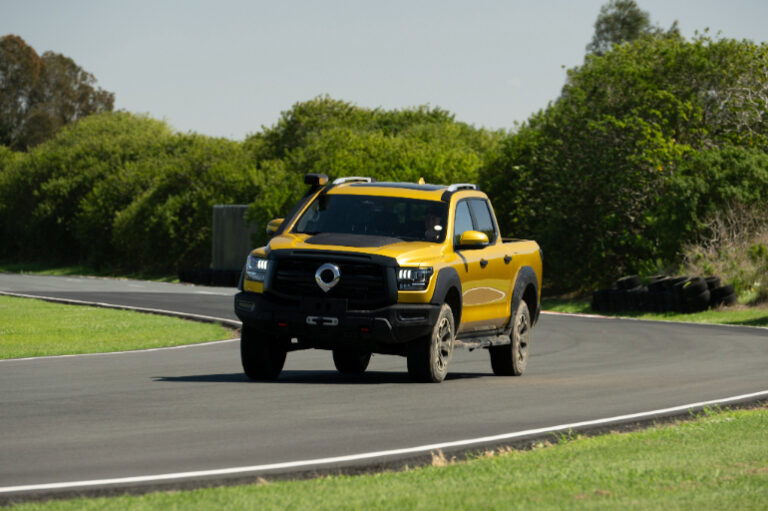GWM showed its plug-in hybrid Cannon Alpha Hi4T model recently, alongside a Tank 500 Hi4T and Ora Sport, at a private test track in Queensland. We spent time on- and off-road in the left-hook version of its flagship PHEV ute, which we think has huge fleet appeal.
While PHEV ute options are non-existent in Australia, despite their fleet suitability compared with all-electric options, 2025 will see the popular Ford Ranger and incoming BYD Shark PHEVs introduced. Now, GWM has entered the race, confirming its Cannon Alpha PHEV will arrive locally in the first half of 2025.
Fleet EV News was one of a handful of media titles given early access to a left-hand drive version, brought in from China for the brief test drive, to assess its suitability for the Australian market.
The impressive model is similar to the existing Cannon Alpha ute, which is a slightly larger version of the base Cannon model, but offers an electric-only driving range of 110km and claimed fuel use of just 1.7l/100km.
While the Cannon Alpha is available with diesel or closed-loop hybrid power currently, the Hi4T model promises improved performance on- and off-road despite its clean credentials.

For starters, the model we tested features a coil-sprung rear-end, which outperformed the leaf-sprung rear in the current range. The PHEV model does however offer less payload than its diesel and hybrid counterparts, with just 535kg on offer – down from 735kg in the closed-loop hybrid Cannon Alpha.
This is in part due to the battery, mounted between the chassis rails at the rear, and 2775kg vehicle weight that eats into the 3310kg gross vehicle mass (GVM). While the Cannon Alpha Hi4T loses payload, it still offers a full 3500kg braked towing capacity.
The Hi4T system, shared across both the Cannon Alpha and Tank 500 PHEV models we tested, is made up of a relatively large 37.1kWh ternary lithium battery pack, 2.0-litre petrol engine and electric motor hooked up to a nine-speed automatic transmission. The system produces a combined 300kW/750Nm.

According to GWM, the system can be charged at up to 50kW, allowing it to go from 30 to 80 percent in 24 minutes. AC charging from empty to full will take around 6.5 hours. It also features vehicle-to-load functionality, putting out up to 3.3kW.
For those needing serious off-road performance, the Cannon Alpha Hi4T has front, centre and rear locking differentials and 224mm ground clearance, which actually puts it ahead of most utes but we weren’t able to properly test it off-road.
How does it drive? We spent a limited amount of time in the Cannon Alpha Hi4T, but across short off-road and on-track sessions it did impress us. We’d need longer in the vehicle to drill down on things like fuel use, though.
The electric-only mode was still powerful enough to use day-to-day, as tested on the track. When we engaged low-range 4×4 though, the electric-only mode appeared to switch back to regular power.

While the interior is relatively high-tech, the flashy colour scheme and graphics are a bit much. Whether the Australian model will receive the same interior treatment is not known, but the loud yellow door card trim felt like it belonged on a wakeboard boat – not in a ute.
A feature we did love is the two-way adjustable second row, which is also heated and ventilated. This is a feature more utes should come with. Another example of GWM’s innovative thinking is the split tailgate, offering fantastic accessibility.
The Hi4T model rides better than its leaf-sprung siblings, but the limited payload will turn off plenty of trade buyers. It is possible GWM will address payload concerns though, because the model we drove was a left-hand Chinese option and not the finalised model we will receive.
We were ultimately impressed by the ride quality, power, and technology when testing the Cannon Alpha Hi4T, but price will be the kicker for fleet customers. If GWM prices the model competitively, we think it has serious potential.
GWM says it will provide more information about pricing and specifications closer to the H1 2025 launch date.







